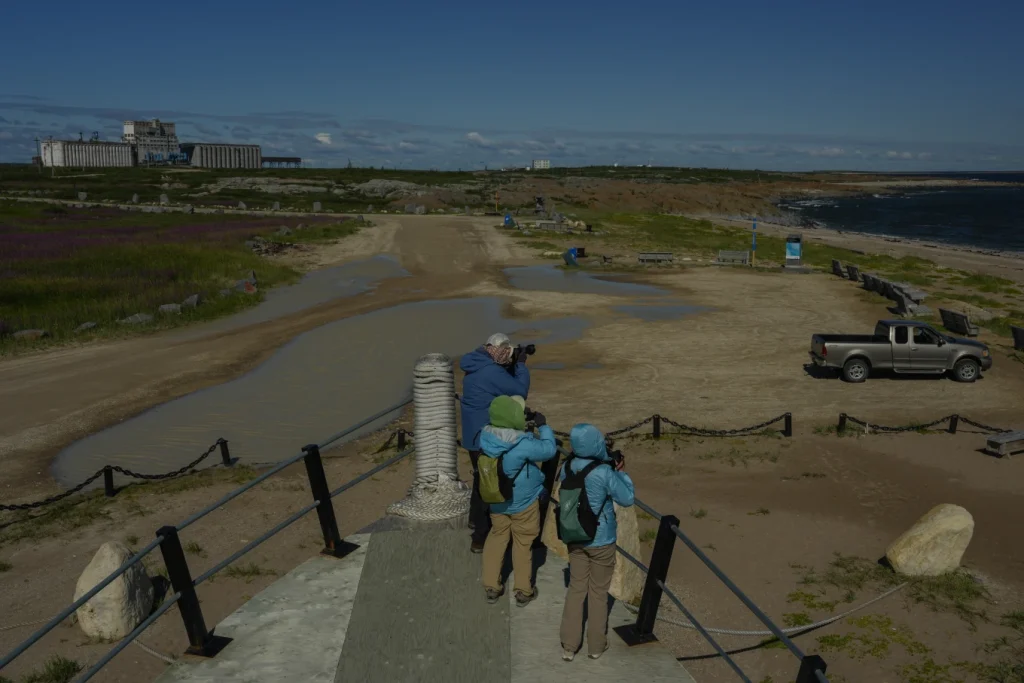Churchill, Manitoba, a remote town situated at the confluence of tundra and forest on the shores of Hudson Bay, stands as a remarkable testament to resilience and adaptability in the face of profound change.
Once a bustling military hub, the town has undergone a dramatic transformation, marked by the collapse of its economic base following the departure of military forces, the cessation of rail service, and the gradual disappearance of vital cargo shipping routes.
This essay explores the multifaceted changes that have reshaped Churchill, highlighting its innovative responses to economic challenges, environmental shifts, and the overarching influence of climate change.
Historically, Churchill thrived as a military and research center, drawing thousands of residents to its shores. The closure of the military base and the rocket research launch site in the late 20th century marked a turning point for the community.
These closures precipitated a significant decline in population and economic activity, leading to the deterioration of vital infrastructure, including the town’s port and railway system.
As a result, Churchill became increasingly isolated, relying on a fragile network of rail and shipping services for supplies and connectivity to the outside world.
The situation was exacerbated by severe weather conditions that rendered the poorly maintained train tracks inoperable, further isolating the community.
As Churchill grappled with these challenges, the impacts of climate change began to manifest in more pronounced ways. The warming climate has led to the shrinking of sea ice in Hudson Bay, which is critical for the survival of polar bears, the town’s most famous residents.
With the ice retreating earlier and forming later each year, polar bears have found themselves increasingly desperate for food, leading them to venture into the town in search of sustenance.
This shift has created both a challenge and an opportunity for Churchill, as the bears, once frightened away by the noise of military operations, have become a central attraction for tourists.
In response to the changing economic landscape, Churchill has strategically pivoted towards tourism, capitalizing on its reputation as the “polar bear capital of the world.”
Local entrepreneurs have developed innovative solutions to safely observe polar bears, such as specialized vehicles designed for bear viewing. The town has successfully marketed itself as a premier destination for wildlife enthusiasts, drawing visitors willing to spend substantial amounts on polar bear excursions.
Reports indicate that tourists spend an average of $5,000 per visit, contributing millions of dollars to the local economy. This shift towards ecotourism has not only provided a financial lifeline for the community but has also fostered a renewed sense of purpose and identity among residents.
Despite the success of polar bear tourism, community leaders recognize the need for diversification to ensure long-term sustainability.
Mayor Mike Spence, who has served the town since 1995, emphasizes the importance of adaptability in the face of inevitable changes. He acknowledges the likelihood of a future decline in polar bear populations due to continued climate change and shrinking ice habitats.
In anticipation of this eventuality, Churchill is actively promoting alternative tourist attractions, including beluga whale watching, northern lights viewing, birdwatching, and traditional activities such as dog sledding.
By broadening its tourism offerings, the town seeks to mitigate potential economic downturns associated with the loss of polar bear tourism.
Churchill’s resilience is further exemplified in its proactive approach to infrastructure challenges. The town has taken ownership of the shuttered port and damaged railway tracks, investing in repairs and revitalization efforts.
Local leaders have recognized the necessity of maintaining transportation links to facilitate tourism and the movement of goods. Moreover, the community has adapted to the physical impacts of climate change, such as ground subsidence due to thawing permafrost.
New buildings, including those of Polar Bears International, have been designed with adjustable metal jacks to accommodate shifts in the ground, demonstrating a commitment to sustainable development practices that prioritize both human safety and environmental preservation.
The demographic composition of Churchill also plays a significant role in its adaptive capacity. Approximately two-thirds of the population is Indigenous, comprising Cree, Metis, Inuit, and Dene communities.
This rich cultural heritage informs the town’s collective approach to problem-solving, as residents draw upon traditional knowledge and a communal mindset that emphasizes resilience and resourcefulness.
Mayor Spence, who grew up in a community that lacked basic amenities such as electricity and running water, embodies this spirit of determination.
He reflects on his father’s aspirations for better communication with officials, stating, “You don’t just say ‘I got a problem.’ You go there with the fix.” This ethos resonates throughout the community, fostering a culture of innovation and collaboration.

In 2018, the Arctic Gateway Group, a coalition comprising 41 First Nations and northern communities, successfully acquired ownership of the port and rail line in Churchill, marking a significant milestone in local governance and economic revitalization.
Following this transition, rail service was reinstated on Halloween of the same year, heralding a new era for transportation in the region.
According to Manitoba officials, the subsequent two years witnessed substantial infrastructure improvements, including the upgrading of 610 kilometers of track and the repair of 10 critical bridges, thereby enhancing the operational capacity of the rail system.
The port’s shipping activity has experienced a remarkable resurgence, with volumes more than tripling since 2021, culminating in the noteworthy return of its first cruise ship in a decade.
Earlier this year, further financial support was announced, with an additional $60 million allocated for the enhancement of port and rail facilities.
Local ownership has been underscored as a pivotal element in Churchill’s development, as articulated by former Chamber of Commerce president Dave Daley, who, despite having left the town in the 1980s, returned after five years, driven by a profound sense of belonging and community.
His reflections on the potential involvement of large hotel chains, which sought to invest in the town’s infrastructure and develop substantial projects, reveal a collective resistance among the residents, who, as Daley noted, are a tightly-knit community with shared values and aspirations for their town’s future.
The evolution of Churchill has also prompted a resurgence of interest in its historical narrative, with tourists increasingly inquiring about the lives and experiences of its residents, as observed by longtime resident Georgina Berg.

She poignantly recounted the “not-so-happy stories” that characterize the community’s past, including forced relocations, the plight of missing women, pervasive poverty, subsistence hunting challenges, neglect, and various forms of abuse, all of which are integral to understanding the socio-cultural landscape of the region, particularly from the perspective of its Cree inhabitants.
Daley, who is also a dogsled racer and president of Indigenous Tourism Manitoba, highlighted the historical marginalization of the Metis people, yet he emphasized a forward-looking perspective, urging the younger generation to focus on actionable change rather than dwelling on past grievances.
He succinctly articulated this philosophy by stating, “We can’t change five minutes ago, but we can change five minutes from now,” encouraging a mindset that prioritizes progress and resilience.
Concurrently, both Daley and Spence have observed the palpable impacts of climate change in their region, noting not only the increasing temperatures but also the unprecedented occurrence of thunder, a phenomenon once considered unimaginable in the Arctic.
With the region warming at a rate four times faster than the global average, Spence acknowledged that while Churchill, situated south of the Arctic Circle, may not be experiencing the most severe effects, the community remains vigilant and proactive in addressing these environmental challenges.
He articulated the necessity of finding a harmonious balance in adapting to climate change, underscoring the importance of collaboration and innovative approaches to navigate the complexities of this pressing global issue.
